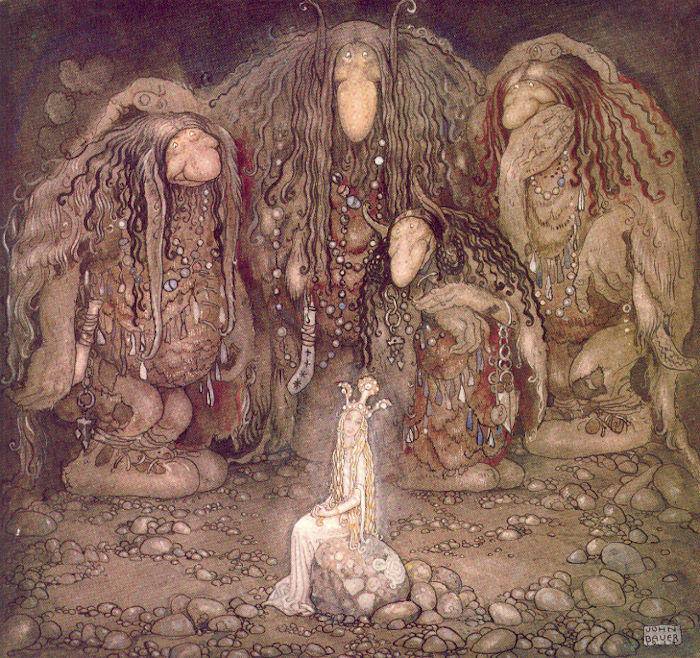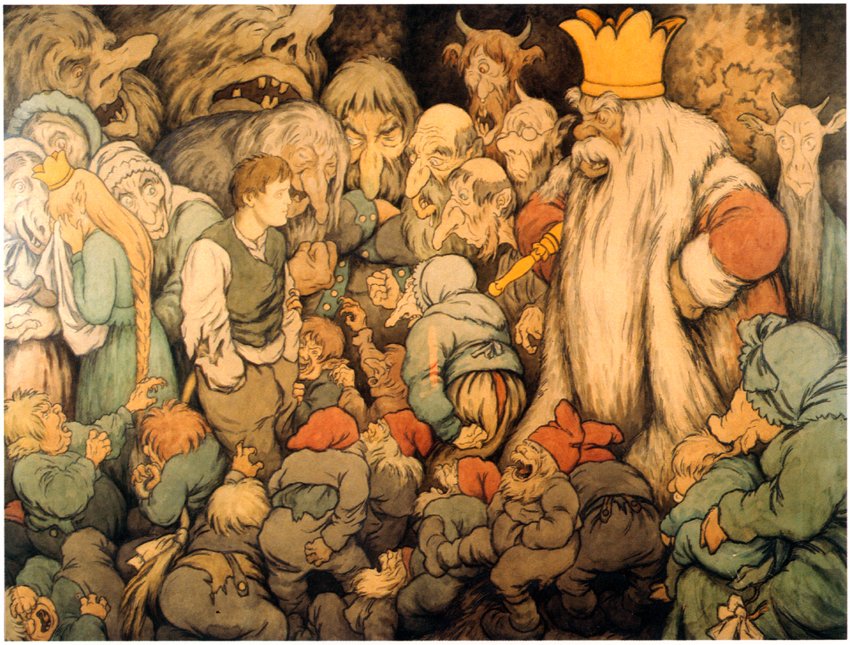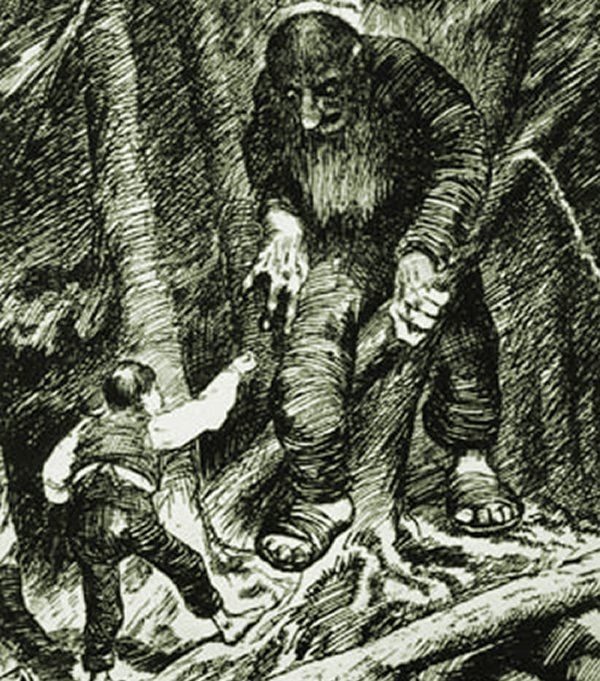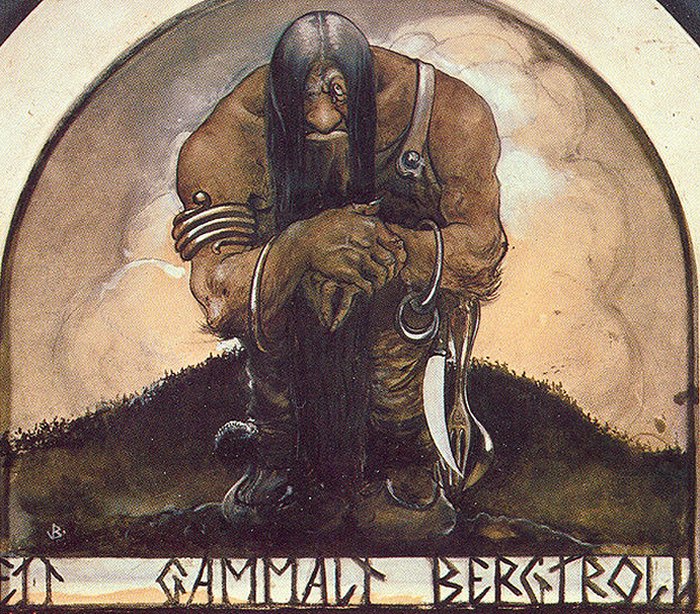Trolls – Fascinating Mythical Creatures Of Scandinavia
A. Sutherland - AncientPages.com - The troll is a fascinating mythological creature, well-known in Scandinavian countries. They were 'nature beings' because encounters with them usually took place in nature. For centuries, however, trolls were found only in the landscape of Scandinavia.
The troll is a fascinating mythological creature featured in the popular Swedish folklore and fairy tales Among Gnomes and Trolls (Swedish: Bland tomtar och troll). Credit: John Bauer
However, a troll is also known in other parts of the world.
'Around 1200, an anonymous poet, possibly from the Orkneys, compiled a poem with a series of proverbial sentiments. One stanza includes the following couplet, which rhymes in the original:
All exaggerations seem short; not much is worse than trolls…' 1
Many still believe in the existence of trolls that have the power to invoke negative feelings in us, like those of the Orkneys' poet, who composed his poem a long time ago.
Another example can be a late Icelandic saga bordering on a fairy tale. It tells of Núdús, the king of Serkland (the Baghdad caliphate).
'He is larger and stronger than every other man and beyond each in every way in that part of the world. He has with himself all kinds of peoples, Africans, and trolls, and berserkers and giants and dwarfs, and other people powerful in magic.
Like many other creatures in folklore of Scandinavia, trolls were said to live in underground complexes, accessible from underneath large boulders in the forests or in the mountains. Credits: Theodor S. Kittelsen
No human person can stand up to him and his army..' 1
Who was this remarkable individual?
Trolls In A Pre-Industrial Society
Tradition around these intriguing creatures is ancient, and so is a common belief in them.
The authors of the most famous images of trolls are in Norway, Theodor Kittelsen and Erik Werenskiold, and in Sweden – John Bauer. Theodor Severin Kittelsen (1857-1914), a great Norwegian artist, is known as the "father" of all trolls. His inspiration came from folktales about wild and stupid trolls, but trolls were not ugly or stupid.
Askeladden and a troll, by Theodor Kittelsen. Public Domain
On the contrary, they were cunning and witchcraft-knowledgeable. Kittelsen's imagination gave the trolls their peculiar appearance. A troll was reputed to be anti-Christian when this religion became a stronghold in Sweden in the 1300s.
According to tradition, the 'smell of Christians' and the sound of church bells could greatly disgust trolls. Their home environment was pre-industrial, where people lived by farming and fishing.
Often Hairy, Huge But Sometimes Looking Like Ordinary Humans
These curious beings were usually hairy, huge, and not intelligent or beautiful. Their varying shapes and sizes made them different from each other in both appearance and character.
They could be described as good neighbors doing small favors to each other or dangerous creatures with a voracious appetite for thieving and causing trouble.
The trolls could attract people into their world, into the mountains, or down into the underworld, and people who disappeared for a while could return with memory loss and confusion still present after returning home. Credit: John Bauer
The trolls could be invisible or behave in the shape of different animals or objects. Still, usually, they looked like ordinary people with beautiful clothes. They lived in larger or smaller families, owned cattle, and could reside underground, in forests, in a castle, under bridges, lakes, and seashores.
Rumors told the king of the trolls lived on a mountain. He was considered a wealthy troll with stored silver and gold piles. The trolls who lived alone and isolated in huts within a forest were deemed the most dangerous.
Most of the trolls were supposed to be creatures old, malicious, and not very intelligent. It was possible to find large specimens and small goblins among them.
Usually, they stole food and drink, but they also stole children and swapped them for their own. These changelings were recognized in various ways; usually, they could not grow up and learn to speak.
The trolls could attract people over a longer or shorter time into their world, the mountains, or the underworld. People who disappeared for a while could return with memory loss and confusion still present after returning home.
But there is a way to eliminate a troll, and many legends and myths relate how trolls were changed to large stones because sunlight is the primary weapon against these creatures. Due to this exposure, a troll becomes harmless. Dwarf Alvis ('All-Wise') was one such creature.
Sometimes, the trolls were described as malicious, but sometimes, they used to get people's credit for their helpfulness.
That's the most significant and intriguing mystery of trolls.
Written by A. Sutherland - AncientPages.com Senior Staff Writer
Updated on Sep 21, 2023
Copyright © AncientPages.com. All rights reserved. This material may not be published, broadcast, rewritten or redistributed in whole or part without the express written permission of AncientPages.com
Expand for referencesMore From Ancient Pages
-
 Anne Neville – The Dramatical Story Of The White Queen
Featured Stories | May 22, 2020
Anne Neville – The Dramatical Story Of The White Queen
Featured Stories | May 22, 2020 -
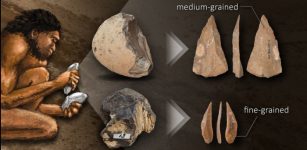 Paleolithic Humans May Have Understood The Properties Of Rocks For Making Stone Tools
Archaeology | Dec 2, 2023
Paleolithic Humans May Have Understood The Properties Of Rocks For Making Stone Tools
Archaeology | Dec 2, 2023 -
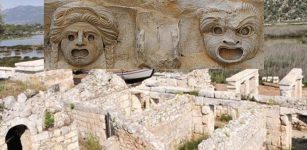 Ancient City Was Discovered Underground In Antalya’s Demre District
Archaeology | Nov 26, 2019
Ancient City Was Discovered Underground In Antalya’s Demre District
Archaeology | Nov 26, 2019 -
 On This Day In History: Storming Of The Paris Fortress – Prison Bastille – On July 14, 1789
News | Jul 14, 2016
On This Day In History: Storming Of The Paris Fortress – Prison Bastille – On July 14, 1789
News | Jul 14, 2016 -
 Why Human Languages Can Be Likened To Branches On A Tree And Help Finding A Single Common Ancestor
Linguistic Discoveries | Sep 11, 2021
Why Human Languages Can Be Likened To Branches On A Tree And Help Finding A Single Common Ancestor
Linguistic Discoveries | Sep 11, 2021 -
 Strange Engraving Made By Knights Templar In French Village – Riddle Of The Rod – Part 1
Ancient Mysteries | Oct 7, 2019
Strange Engraving Made By Knights Templar In French Village – Riddle Of The Rod – Part 1
Ancient Mysteries | Oct 7, 2019 -
 Amazing Adventure Of The Viking Who Escaped A Death Sentence Using His Artistic Talents
Featured Stories | Feb 9, 2025
Amazing Adventure Of The Viking Who Escaped A Death Sentence Using His Artistic Talents
Featured Stories | Feb 9, 2025 -
 Siberian Neanderthals Were Intrepid Nomads – They Started Their Journey In Eastern Europe
Archaeology | Jan 29, 2020
Siberian Neanderthals Were Intrepid Nomads – They Started Their Journey In Eastern Europe
Archaeology | Jan 29, 2020 -
 1,500-Year-Old Joint Burial Offers A Look Into Attitudes Toward Love And The Afterlife
Archaeology | Sep 14, 2021
1,500-Year-Old Joint Burial Offers A Look Into Attitudes Toward Love And The Afterlife
Archaeology | Sep 14, 2021 -
 Evidence Of The 586 BCE Babylonian Destruction Of Jerusalem’s Monumental Building – Reconstructed
Archaeology | Jul 28, 2023
Evidence Of The 586 BCE Babylonian Destruction Of Jerusalem’s Monumental Building – Reconstructed
Archaeology | Jul 28, 2023 -
 On This Day In History: Ueshiba Morihei, The ‘Founder of Aikido’ Was Born – On Dec 14, 1883
News | Dec 14, 2016
On This Day In History: Ueshiba Morihei, The ‘Founder of Aikido’ Was Born – On Dec 14, 1883
News | Dec 14, 2016 -
 Strange 1,000-Year-Old Artifact Melted Out Of The Ice Identified With Help Of Photo!
Archaeology | Jan 31, 2023
Strange 1,000-Year-Old Artifact Melted Out Of The Ice Identified With Help Of Photo!
Archaeology | Jan 31, 2023 -
 Louhi – Witch Goddess Of The North And The Magical Artifact Sampo In Finnish Mythology
Featured Stories | Sep 21, 2017
Louhi – Witch Goddess Of The North And The Magical Artifact Sampo In Finnish Mythology
Featured Stories | Sep 21, 2017 -
 Ancient Egyptian Capital Tell El-Amarna Mapped Through Satellite Imagery System
Civilizations | Sep 11, 2015
Ancient Egyptian Capital Tell El-Amarna Mapped Through Satellite Imagery System
Civilizations | Sep 11, 2015 -
 ‘Impossible’ Advanced Ancient Technology In Mesopotamia – Evidence Of Other-Worldly Interaction?
Ancient Mysteries | May 24, 2021
‘Impossible’ Advanced Ancient Technology In Mesopotamia – Evidence Of Other-Worldly Interaction?
Ancient Mysteries | May 24, 2021 -
 Researchers Will Search For “Fingerprints” Of Thera/Santorini Eruption In Tree Rings
Archaeology | Mar 4, 2017
Researchers Will Search For “Fingerprints” Of Thera/Santorini Eruption In Tree Rings
Archaeology | Mar 4, 2017 -
 25,000 Ancient Egyptian Statues, Ushabti Figurines And Artifacts From New Kingdom Cemetery Revealed For The First Time
Archaeology | Oct 26, 2023
25,000 Ancient Egyptian Statues, Ushabti Figurines And Artifacts From New Kingdom Cemetery Revealed For The First Time
Archaeology | Oct 26, 2023 -
 King Seqenenre Taa II Was Killed By Hyksos Invaders – Mummy Scans Reveal His Wounds
Archaeology | Feb 17, 2021
King Seqenenre Taa II Was Killed By Hyksos Invaders – Mummy Scans Reveal His Wounds
Archaeology | Feb 17, 2021 -
 Few Witches Were Executed In Wales In The Middle Ages – Why?
Featured Stories | Oct 29, 2024
Few Witches Were Executed In Wales In The Middle Ages – Why?
Featured Stories | Oct 29, 2024 -
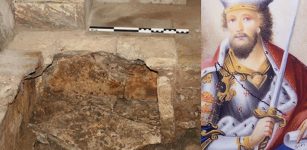 Location Of Burial Place Belonging To Alexander Nevsky’s Son And Grandson – Found
Archaeology | May 3, 2021
Location Of Burial Place Belonging To Alexander Nevsky’s Son And Grandson – Found
Archaeology | May 3, 2021

